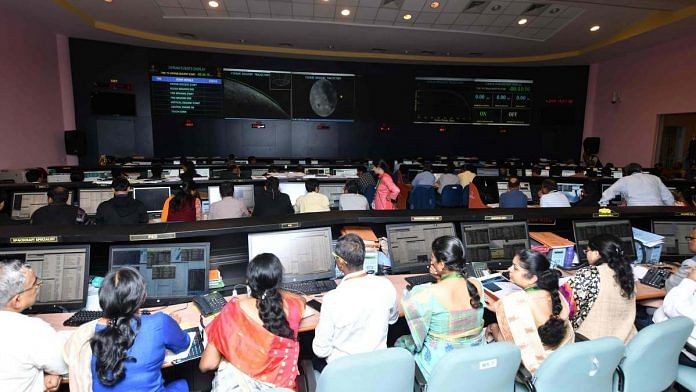
New Delhi: India lost communication with Chandrayaan-2 just moments before the final moon landing, ISRO chief K. Sivan said early Saturday.
“Vikram lander descent was as planned and normal performance was observed upto an altitude of 2.1 km. Subsequently, the communications from the lander to ground station was lost. The data is being analysed,” Sivan announced.
Prime Minister Narendra Modi, who was watching the landing from the mission control room, told the scientists minutes later, “It’s not a small thing that we have achieved. Be courageous.”
This is Mission Control Centre. #VikramLander descent was as planned and normal performance was observed up to an altitude of 2.1 km. Subsequently, communication from Lander to the ground stations was lost. Data is being analyzed.#ISRO
— ISRO (@isro) September 6, 2019
India is proud of our scientists! They’ve given their best and have always made India proud. These are moments to be courageous, and courageous we will be!
Chairman @isro gave updates on Chandrayaan-2. We remain hopeful and will continue working hard on our space programme.
— Narendra Modi (@narendramodi) September 6, 2019
The touchdown on the south pole of the Moon was expected at 1.55am. The 15 minutes prior to that, involving the ‘rough braking’ phase and ‘fine braking’ phase for the Vikram lander, were described by Sivan as “terrifying” last month.
In those 15 minutes the Vikram lander was expected to perform a powered descent. The process of landing was supposed to involve the lander’s engines firing in the opposite direction to slow it down to an optimal speed to ensure it doesn’t crash on the lunar surface. In April this year, a private Israeli spacecraft called Beresheet had crashed while performing such a landing when the craft’s main engine shut off during the braking procedure.
The loss in communication is reminiscent of India’s first mission to the Moon, Chandrayaan-1, launched in 2008, which ended prematurely owing precisely to this reason. ISRO has enjoyed a high success rate in its missions, including rocket launches, satellite deployments, and interplanetary missions. Even if communication is never established, the mission will not be deemed a total failure as the orbiter is well and working, with eight functioning payloads.
The Vikram lander — named after Vikram Sarabhai, the “father of Indian space programme” — and the Pragyan rover, named after the Sanskrit word for “knowledge”, carry a total of six instruments for different studies on the lunar surface.
Also read: Why Chandrayaan-2 is ISRO’s ‘most complex mission’ so far
The mission
The spacecraft was expected to undertake a complex mission, studying different aspects of the Moon, including lunar quakes and the constitution of its soil, for a likely duration of just about half a Moon day, or 14 Earth days.
Apart from these tasks, these payloads were also expected to measure the thickness of the regolith or lunar soil, study the density of water ice — whose presence on the Moon was confirmed by Chandrayaan-1, dig into the soil to understand heat conductivity, and blast laser pulses to analyse minerals.
Chandrayaan-2 was launched on 22 July aboard the Rs 375 crore GSLV Mk-III, which is currently India’s most powerful launcher. An earlier launch, scheduled for 15 July, was called off minutes before takeoff after the discovery of a technical glitch.
It weighed 3,850 kg at launch, with a mass of 1,308 kg without fuel. The orbiter, lander, and rover weigh 682 kg, 626 kg, and 27 kg, respectively. The lander separated from the orbiter in lunar orbit on 2 September.
The Rs 603 crore mission is expected to last a year, potentially extending up to two.
Also read: Chandrayaan-2 ‘cheaper than Interstellar’, but India’s space ambition can’t be about cost
This report has been updated with additional information

Cheers and thanks to all the scientists?. You did a great job.
Better luck next time. Hopefully what you learned this time will help next time.
Tantalisingly close. May ISRO continue to make us proud.